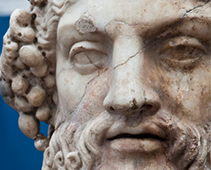In the 500s BC the tombs were protected by statues of lions, bulls, and sphinxes in marble.
A GREEK CEMETERY
GRAVES
In the 500s BC the tombs were protected by statues of lions, bulls, and sphinxes in marble. Sometimes they were placed in pairs as is the case with the Glyptotek’s two lions. Graves for young men who had made themselves conspicuous in battle or in athletic competitions were honoured with a nude statue of a youth, a kouros, such as the torso from Paros or the Rayet Head from Athens.
From 500 until 430 BC only cenotaphs for soldiers who died in battle for their city far from home could be adorned so handsomely.
The best known necropolis is the Kerameikos, just outside the walls of Athens. A large number of marble tomb reliefs from here dating from the Classical period, c. 430 – 317 BC have been preserved. They show the deceased and their families and often have an inscription giving the name of the deceased.
Reliefs of this kind range in quality from the excellent to the mediocre. This shows that in this period the ordinary citizen could afford a relief. Another type of grave marker is a solid marble vase. The shape, a lekythos, was an oil container, often used as a grave gift. In 317 BC a ban on funerary luxury was introduced in Athens and the tombs were no longer adorned with marble sculpture.




